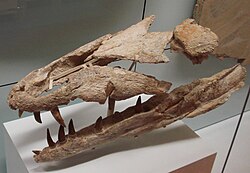Metriorhynchid
| Metriorhynchidae Temporal range: Middle Jurassic-Early Cretaceous, 170–125 Ma |
|
|---|---|
 |
|
| Dakosaurus maximus skull, Staatliches Museum für Naturkunde Stuttgart | |
| Scientific classification | |
| Kingdom: | Animalia |
| Phylum: | Chordata |
| Class: | Reptilia |
| Suborder: | †Thalattosuchia |
| Superfamily: | †Metriorhynchoidea |
| Family: |
†Metriorhynchidae Fitzinger, 1843 |
| Subfamilies | |
| Synonyms | |
|
|
Metriorhynchidae is an extinct family of specialized, aquatic metriorhynchoid crocodyliforms from the Middle Jurassic to the Early Cretaceous period (Bajocian - Valanginian stages) of Europe, North America and South America. The name Metriorhynchidae was coined by the Austrian zoologist Leopold Fitzinger in 1843. The group contains two subfamilies, the Metriorhynchinae and the Geosaurinae.
Metriorhynchids are fully aquatic crocodyliforms. Their forelimbs were small and paddle-like, and unlike living crocodilians, they lost their osteoderms ("armour scutes"). Their body shape maximised hydrodynamy (swimming efficiency), as did having a shark-like tail flukes.
Metriorhynchids were the only group of archosaurs (aside from seabirds, and technically pelagic pterosaurs such as nyctosaurids) to become fully adapted to the marine realm, becoming pelagic in lifestyle. With tail flukes, reduced limb musculature, and long bones histologically comparable to other obligately aquatic animals, they were almost certainly incapable of terrestrial locomotion; combined with an unusually tall hip opening, as also seen in other obligately aquatic reptiles including the viviparous Keichousaurus, this has lent credence to the suggestion that metriorhynchids gave live birth.
...
Wikipedia
